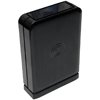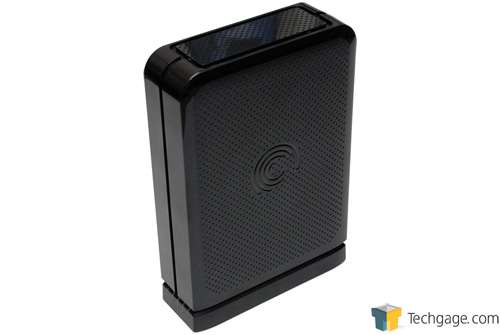- Qualcomm Launches Snapdragon 4 Gen 2 Mobile Platform
- AMD Launches Ryzen PRO 7000 Series Mobile & Desktop Platform
- Intel Launches Sleek Single-Slot Arc Pro A60 Workstation Graphics Card
- NVIDIA Announces Latest Ada Lovelace Additions: GeForce RTX 4060 Ti & RTX 4060
- Maxon Redshift With AMD Radeon GPU Rendering Support Now Available
Seagate FreeAgent GoFlex Desk 3TB

With our media collections growing larger by the day, it’s sad to look at a 2TB hard drive and picture it as not being “large enough” for our goods. To help remedy things a bit, Seagate recently released a 3TB external drive, and it today remains the only 3TB single drive offering. Let’s take a look and see if it’s worth your consideration.
Page 6 – Final Thoughts
It’s not often that we see a hard drive come to market that literally boosts the total storage density by 50% compared to the previous reigning champion, but that’s just what we saw this past summer with the release of Seagate’s first 3TB offering. Even today, no other vendor has followed-up with their own 3TB models, leaving Seagate in a good place – at least for now.
The big question, then, is whether or not 3TB is something you’d want to jump oat, or if the FreeAgent GoFlex Desk in particular is a winner in our book. The answers to those questions are a bit varied depending on what we’re talking about.
First, the drive looks fantastic. It features a clean design that will look good on most any desk, and despite the lack of active cooling, the enclosure itself is never that hot to the touch. The interchangeable docks is a nice feature, but as I mentioned earlier, I don’t like the fact that they inflate the end price for the unit. It just doesn’t seem fair to the consumer.
Performance-wise, the drive delivered on all fronts. When in USB 2.0 mode, it easily topped out the capabilities of the port, and when shifted over to USB 3.0, it performed on par with a desktop drive. Having this kind of storage sitting on your desk along with those speeds is just amazing. If there’s any sort of inconvenience, it’s that it requires external power, but that’s no surprise given that it’s in essence a desktop hard drive, though.
Some of the downsides with this drive aren’t the fault of Seagate, but just come with the territory of 2.2TB+ drives. In order to have them operate, there are many things that need to be in place, such as a capable OS, drivers and other things. But fortunately for consumers, the solution here is a no-brainer, as you simply plug it in and use it… no configuration required. The situation will become a little more complex once 3TB internal drives come to market, and that’s no doubt one of the main reasons Seagate nor anyone else have been in a rush.
Aside from the added price of the docks and anything else that might be wrong with this drive, its high temperatures are a bit hard to ignore. For internal drives, it’s not uncommon to see temperatures of around 45°C or even as high as 50°C, but even at the high-end, it’s not “dangerous”. This drive, though, saw temperatures as high as 66°C during testing, and that to me is high. If I saw the same temperatures on my internal drives, it’d cause me to shut down immediately and figure out what was going on.
Even during large file copy processes, the enclosure itself didn’t feel too warm, but it’s the drive that matters, and when it’s nearing the 70°C mark, it actually seems like there’d be a good reason to see an external enclosure with a fan of some sort, or at least one that’s a bit larger thanks to an improved heatsink. Of course, these two things go against what most people want… a slim enclosure.
Admittedly, the drive isn’t going to be hovering above 60°C unless you are using it, but let’s face it… if you are in the market for a 3TB drive, chances are good that you have plans to use it a lot. Not everyone feels the need to equip themselves with three-thousand freaking gigabytes, after all.
Even after large file transfer operations are done, the drive takes a long time to cool down, due to the lack of real airflow. When I decided to check up on the actual drive temperature with a temp gun, I unplugged it to let it sit a couple of minutes, then began taking the enclosure apart. I then started to remove the drive, and even five minutes after powering it down, the drive was still too hot to touch in certain areas. It was not too long after this when I measured 52°C on the exterior of the drive. Inside its enclosure, that kind of heat would take even longer to clear out.
Harping on the temperatures aside, the FreeAgent GoFlex Desk 3TB offers many good things, but a purchase should be heavily thought about. If you truly need huge external storage, it’s still worth a consideration as long as you keep the temperature issues in mind, but if you don’t, 2TB externals should prove to be a better choice for now.
Discuss this article in our forums!
Have a comment you wish to make on this article? Recommendations? Criticism? Feel free to head over to our related thread and put your words to our virtual paper! There is no requirement to register in order to respond to these threads, but it sure doesn’t hurt!
Support our efforts! With ad revenue at an all-time low for written websites, we're relying more than ever on reader support to help us continue putting so much effort into this type of content. You can support us by becoming a Patron, or by using our Amazon shopping affiliate links listed through our articles. Thanks for your support!






